Work, rest and pay: Civil Service engagement in departments
Most civil servants are happy, but there are still areas to improve.
Continuing with this year’s Civil Service People Survey, the Whitehall Monitor team look at departmental results in more detail. Petr Bouchal and Gavin Freeguard find that most civil servants feel generally positive about their jobs but are less happy about pay, learning and development and how their departments manage change.
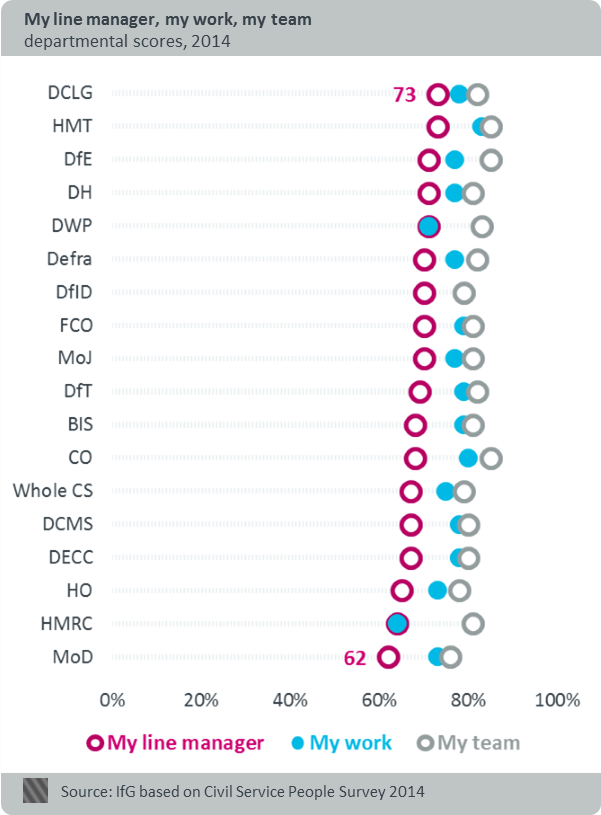
As we explained in our previous post on the Civil Service People Survey, the questions civil servants are asked are clustered in several themes. A score of 100% means that civil servants strongly agree with the question asked, 75% that they agree, 50% that they neither agree nor disagree, 25% that they disagree and 0% that they strongly disagree. Our analysis of the responses from the 17 main departments suggests that working in a particular department influences civil servants’ perception of their work in some areas more than others (see chart above).
Civil servants like their work and their teams and managers, regardless of where they work.
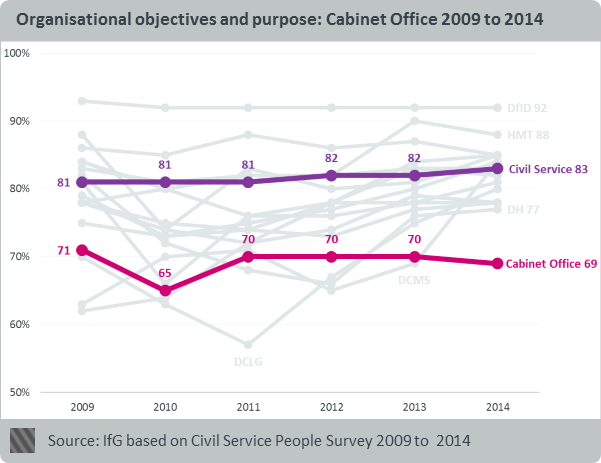
All departments score above 75% on the 'my team' theme, above 60% for 'my line manager', and only HM Revenue and Customs (HMRC) scores below 70% on 'my work', with little variation between departments. On these three themes, most departments’ scores rose and most departments’ scores exceed their score for overall engagement.
Staff are also quite clear about why they do what they do – though less so in Cabinet Office.
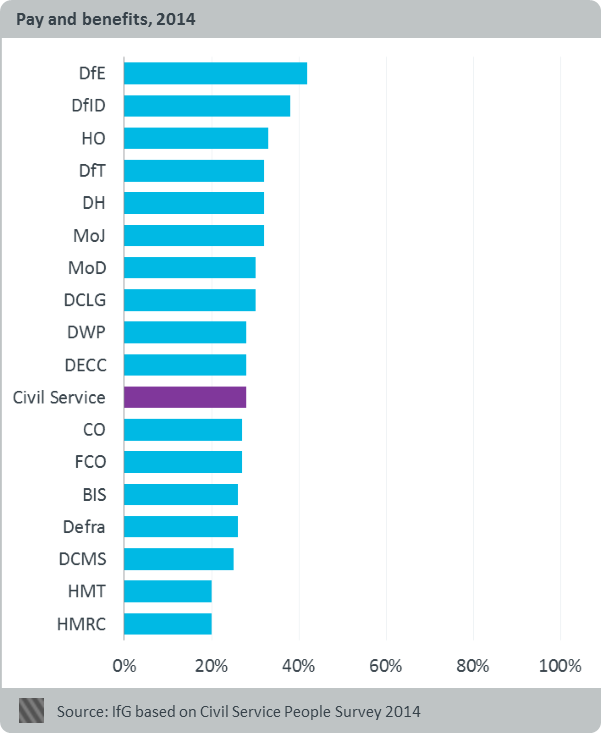
When civil servants were asked about 'organisational objectives and purpose' – whether they have a clear understanding of their department’s purpose, whether they have a clear understanding of their department’s objectives, and whether they understand how their work fits in with those objectives – all but three departments had relatively similar and high scores between 75% and 85%. The Treasury (88%) and the Department for International Development (DfID, at 92%) stand out at the top. Staff at the Cabinet Office, on the other hand, are less clear about the organisation's purpose, scoring at 69%.
But civil servants are unhappy with their pay and benefits – although in the Department for Education (DfE) this is less pronounced.
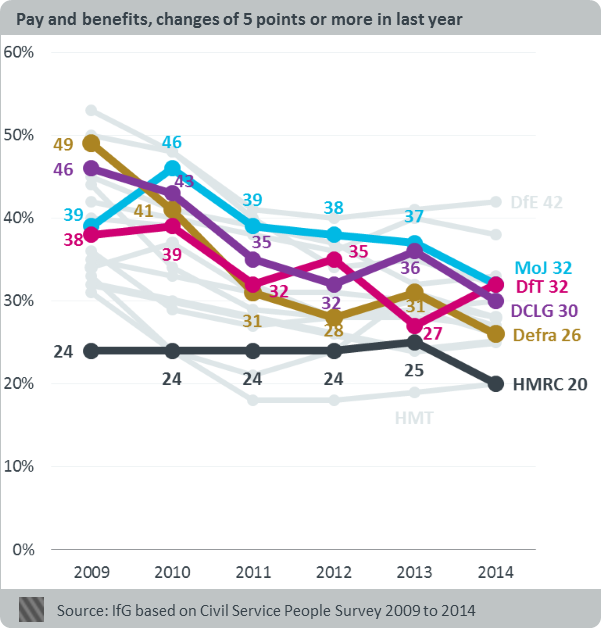
DfE's score is at 42%, which is followed by DfID at 38%. At the other end of the scale, the Treasury and HMRC – which are at opposite ends of the Engagement Index – are both at 20%.
The pay and benefits scores have been getting worse over the years.
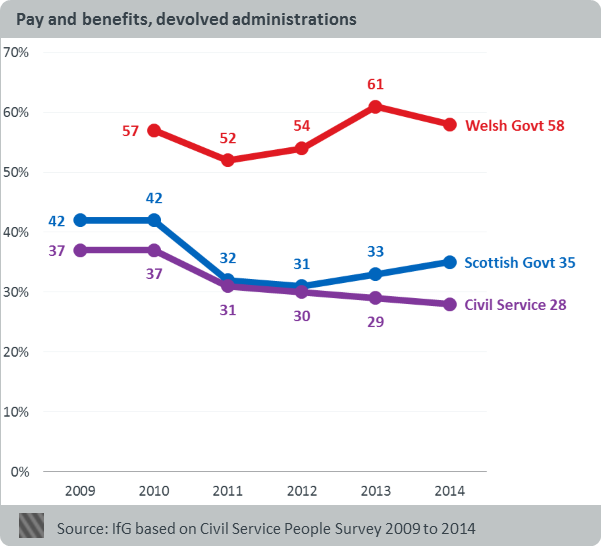
The pay and benefits score fell for 11 of the 17 main departments and is now the lowest on record for nine of these departments. The Department for Communities and Local Government (DCLG), HMRC, the Department for Environment, Food and Rural Affairs (Defra) and the Ministry of Justice (MoJ) all saw substantial decreases. Only the Department for Transport (DfT) saw a significant increase (of five points). As we have previously highlighted, continued pay restraint in the Civil Service reflected by these scores will mean leaders of Whitehall departments need other ways of motivating and retaining key staff.
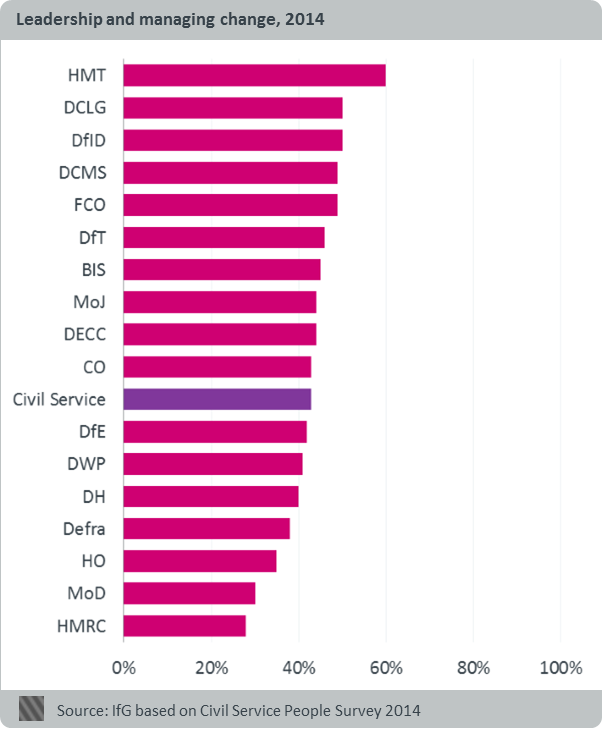
Interestingly, there is a marked difference between the Civil Service as a whole and the two devolved administrations included in the survey. Civil servants in the Scottish Government are slightly happier about pay than the Civil Service as a whole; although their score is lower than in 2010, it has increased since 2012 while the whole Civil Service has declined. Civil servants in the Welsh Government, on the other hand, are 30 points more positive about pay than the civil service median – and at 58%, one point happier than in 2010.
There are also differences in how well civil servants think change is managed in their departments – HMT is top, HMRC bottom.
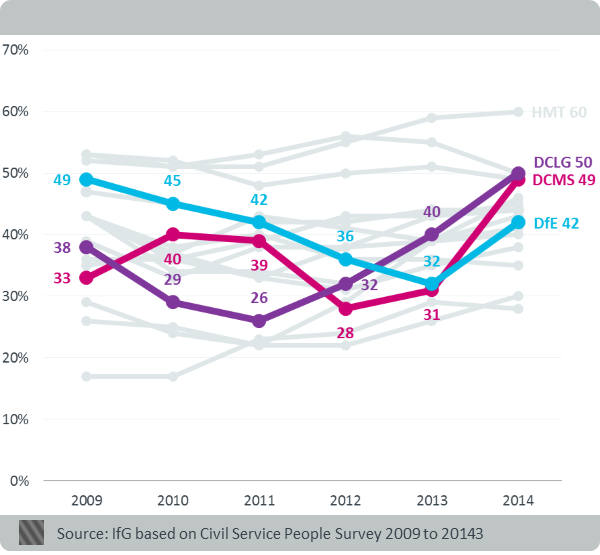
As we have previously noted, and in spite of staff cuts and budgetary pressures, some departments have undergone considerable changes in what they do and how they operate since 2010. According to the survey, some departments have handled this better than others. The Treasury stands out, leading the pack with a score of 60%, 10 points above DCLG in second place. Staff in the Ministry of Defence (MoD) and HMRC are least happy with leadership and change management in their departments, with scores of 30% and 28%, respectively.
Civil servants are more impressed with leadership and the management of change this year than last in DfE, Department for Culture, Media and Sport (DCMS), DCLG, MoD and Cabinet Office (CO).
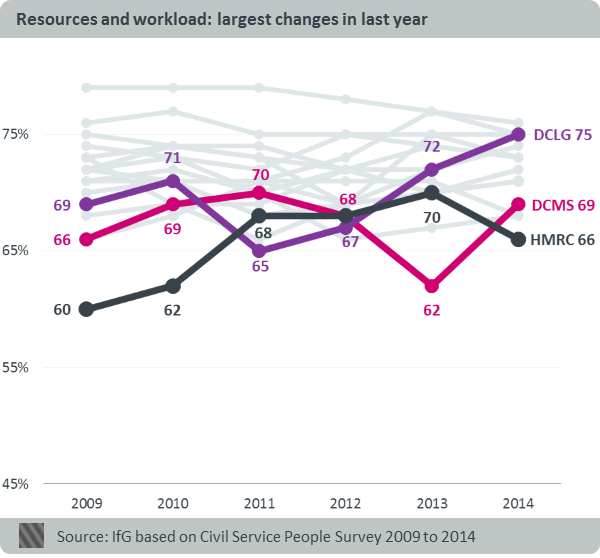
DCMS improved by 18 points – as we've noted for the increase in its Engagement Index score overall, this may be affected by the large increase in response rate from last year. DCLG and DfE (which we’ll look at in a future post) saw a 10 point rise while DfT's score went up by seven points. DfID was the only department to see a sizeable drop (down five points.)
Finally, perceptions of 'resources and workload' are not as gloomy as the staff cuts might suggest.
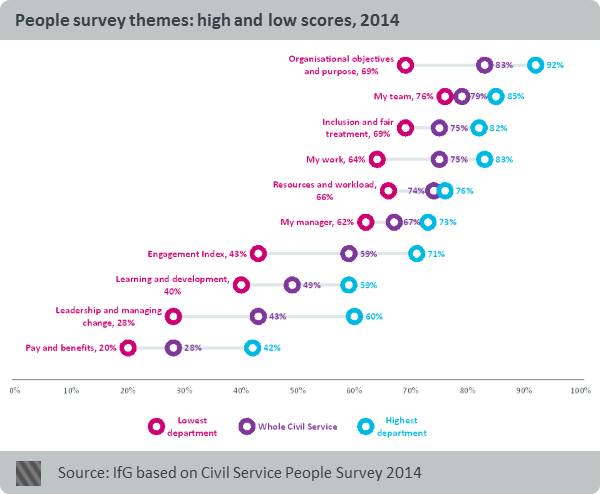
All departments have relatively high scores between 66% and 76%. DCMS and DfE, both of which have been through some of the largest cuts in Whitehall, have seen increases for the third and fourth consecutive year, respectively. DCMS saw a large increase, which might reflect some stability following an acceleration of staff cuts in the department in the last year (figure 4.7). Meanwhile, scores fell at HMRC (down four points) and in six other departments. Of the three departments where comparable data show increases in staff numbers over the last year, DECC and CO saw small increases (up one and two points) and DfID saw no change to this score.
With further staff cuts expected across the next year (if the Government’s estimate is to be met) and beyond, this is an area that could come under further pressure. Based on this data alone, we can only speculate why some departments fare better than others on specific measures. As our recent Whitehall Monitor annual report makes clear, departments vary on a range of dimensions, from their grade mix to the scale of change in how they operate, which could make it more or less difficult for them to maintain staff engagement. A close look at how departments fare on individual aspects of staff engagement is a first step towards addressing the challenge of engaging staff, which is unlikely to go away with further budget cuts and pressure for change in the coming years.
- Topic
- Civil service
- Keywords
- Civil servants Civil service reform Austerity
- Administration
- Cameron-Clegg coalition government
- Tracker
- Whitehall Monitor
- Publisher
- Institute for Government